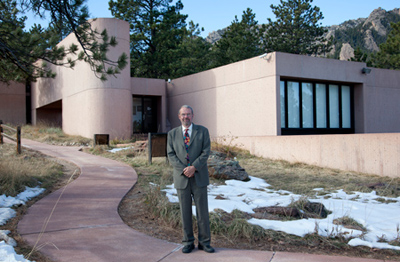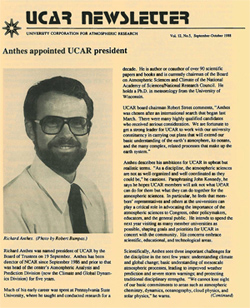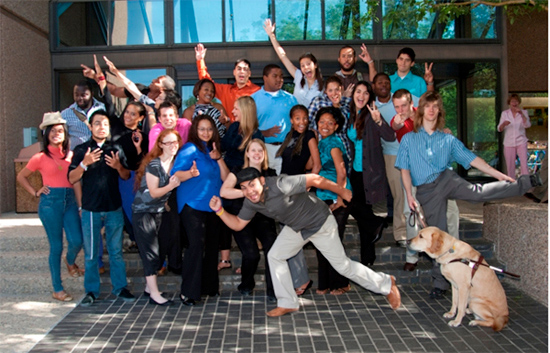Moving on
Dec 29, 2011 - by Staff
Dec 29, 2011 - by Staff
29 December 2011 • It’s late in the year and late in my tenure as UCAR president as I write this, the 75th and last of my “President’s Corner” essays. Early next year (9 January, to be exact), after almost 24 years as UCAR president, I turn over the reins of leadership to the capable hands of Tom Bogdan.

I thank all my friends and colleagues at NCAR and UCAR, the universities, U.S. federal agencies (particularly NSF), and the international community for their support, friendship, and partnership in many successful projects over the years. I look forward to continuing to work with many of you in the months and years to come.
I have enjoyed writing these articles (which are archived at the website of the UCAR President's Office). They have allowed me to cover such diverse topics as climate change and weather extremes; observations of Earth from space; population growth; politics and science; equity and other social issues; free and open data exchange; science in Cuba, India, and China; science communication; hurricanes and winter storms; predictability and chaos; and a variety of UCAR issues. But what to do for the last one?
Rather than attempt to summarize all that has happened in our community in the quarter of a century since I became UCAR president, I decided to share a few general impressions about what has changed since then, what has remained more or less the same, and how things might change in the future.
The biggest change affecting the scientific and academic community since 1988 has been the full-blown development of cyberinfrastructure and computing, including email; the Internet; personal computers and smart communication devices of various types, particularly mobile phones; and social networks.
In 1988, when the UCAR Board of Trustees appointed me president, my office was using large, clumsy word-processing machines, essentially smart typewriters. Email was used almost exclusively by scientists through a primitive dial-in system called OMNET, for which there was a monthly charge. Computers were used only by scientists and “programmers,” as they were called then.

When I was appointed president in 1988, the UCAR Newsletter (which preceded UCAR Magazine) was distributed in print form only.
All of this changed rapidly as the Internet developed. Email became free and ubiquitous, and virtually everybody began using personal computers, not only for word processing, but for many other software applications such as budget development and other data manipulation exercises on spread sheets, preparation of graphics for publications and presentations, and even simple mathematical models. Use of first-class mail dropped off as email correspondence took its place (I almost never receive first-class mail at the office or home any more). And communication that never could or would have occurred before became common. Can you imagine getting more than a hundred personal messages every day by snail mail?
Overall, these changes increased productivity and made it easier to communicate quickly and informally, but there were serious side effects. Angry or ill-chosen words that never would have been sent by mail were sent to people without care or thought, often when the writer was tired, angry, or had had a little too much to drink. Careless words were intercepted, stolen, misinterpreted, and preserved forever, sometimes circulating around the world and politicized, as in the “Climategate” fiasco. For all of us it became difficult to read even superficially, much less carefully, all of the material that continuously streams in day and night from all parts of the world.
In my view, this steady barrage of information (and misinformation) has contributed to less-focused attention to high-priority issues—a form of attention disorder. This unending stream of correspondence, alerts, appeals for money, advertising, and references to web sites and blogs has fostered an environment akin to swatting flies in dealing with a swarm of distracting issues—minor, intermediate and major—all at the same time. I wrote about some of these issues in my President’s Corner of December 2009, “The Vast Wasteland Expands”. Studies have shown that such “time sharing” or multitasking, which is great for computers, is seductive to humans, wastes time, reduces productivity, and diminishes the quality of work. Like any set of powerful tools or medicines, cyber-infrastructure has enormous capability for good, but we must also acknowledge its flip side—its ability to support destructive behavior.
There has been impressive progress in technology development and research in the atmospheric sciences community over the past few decades, which has contributed to much-improved understanding of the sun and the Earth system as well as advances in societal applications such as weather forecasting. However, the fabric of UCAR and NCAR, and the community we interact with, has changed little over the past 25 years. Significantly, in my view, most of the people at all levels in our community—teachers, administrators, program managers, scientists, engineers, and support staff—have remained excellent, dedicated, and productive, proud of their work and supportive of each other. Close to home, the people who lead and manage UCAR and NCAR have worked hard to be fair and transparent and do the best thing for their staff, the institution, and the community.
The issues associated with UCAR-university relations, including the perennial budget challenges, have also remained basically the same. The primary issue of tension associated with competition between the universities and NCAR remains, but it is at least partially relieved in several ways:

Protégés from the SOARS (Significant Opportunities in Atmospheric Research and Science) class of 2010. I have been fortunate to be part of the development and growth of this program, which has nurtured nearly 150 young people from broad backgrounds since the inaugural class of 1996.
As the eminent physicist Niels Bohr (1885–1962) said, “Prediction is very difficult, especially about the future.” Prediction is especially difficult at the present tumultuous and unstable time in U.S. and world history, as virtually every country and culture is being challenged from within as well as without. Threats of a worldwide depression are mentioned nightly as Europe faces an unprecedented debt crisis, and economic recovery proceeds at a painfully slow rate here in the United States. U.S. political leaders seem bent on cutting federal funding at any cost, and certainly one of the casualties is investment in science and education, as well as the infrastructure that supports an advanced civilization. Many people seem to be increasingly skeptical or even hostile to science, or at least to science that does not support their ideologies and beliefs. Leaders have been unable to ask for sacrifice and investment in the solution of long-term problems and the realization of opportunities that could make life safer and richer. (Another manifestation of attention disorder?)
One can easily imagine a dire future scenario, consistent with these indicators, in which the nation and the world revert to a dysfunctional array of poor, uneducated, quarrelling tribes that can’t even agree on the facts, much less on a collective way forward. In this cultural and political environment, our unprepared society would become increasingly vulnerable to social unrest and environmental threats.
Yet the need for a broad education for all, the promise of science and applications for the benefit of society, and the opportunities created by technology have never been greater. We have the observational, computational, and communication tools to understand our environment as an integrated whole, and to use that understanding to improve and protect the lives of people everywhere. Communication has the potential to spread knowledge and stimulate the understanding and tolerance of people and societies different from us. It is thus just as easy to imagine an enlightened future—one in which society flourishes in an environment of increased knowledge and awareness—as it is to imagine the alternate scenario of decay and ruin.
Unlike countless other species that have become extinct or irrelevant, we have the capability of making choices that lead us into a more stable and prosperous future. As has always been the case, we look to the people of younger generations to make the right choices, and there is every hope and indication that they are up to the task. The young people at UCAR, including NCAR postdoctoral researchers and SOARS protégés, support this vision of a better world, as do my children and their friends.
In this optimistic frame of mind, I end my President’s Corner series with a quote from Thomas Paine’s Common Sense, written in 1776 in another period of unrest and disorienting change in the US:
“We have it in our power to begin the world over again.”
Happy new year, everyone!